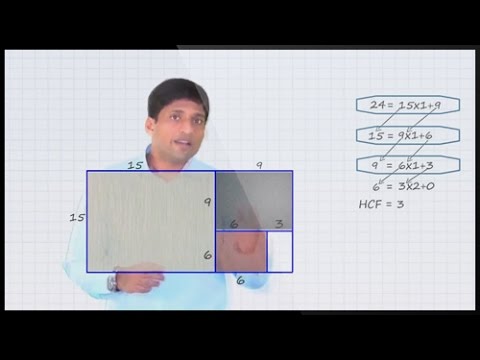Euclid’s Division Lemma: An Introduction
According to Euclid’s Division Lemma if we have two positive integers a and b, then there exist unique integers q and r which satisfies the condition a = bq + r where 0 ≤ r < b.
The basis of the Euclidean division algorithm is Euclid’s division lemma. To calculate the Highest Common Factor (HCF) of two positive integers a and b we use Euclid’s division algorithm. HCF is the largest number which exactly divides two or more positive integers. That means, on dividing both the integers a and b the remainder is zero.

Let us now get into the working of this Euclidean algorithm.
Euclid’s Division Lemma Algorithm
Consider two numbers 78 and 980 and we need to find the HCF of these numbers. To do this, we choose the largest integer first, i.e. 980 and then according to Euclid Division Lemma, a = bq + r where 0 ≤ r < b;
980 = 78 × 12 + 44
Now, here a = 980, b = 78, q = 12 and r = 44.
Now consider the divisor 78 and the remainder 44, apply Euclid division lemma again.
78 = 44 × 1 + 34
Similarly, consider the divisor 44 and the remainder 34, apply Euclid division lemma to 44 and 34.
44 = 34 × 1 + 10
Following the same procedure again,
34 = 10 × 3 + 4
10 = 4 × 2 + 2
4 = 2 × 2 + 0
As we see that the remainder has become zero, therefore, proceeding further is not possible. Hence, the HCF is the divisor b left in the last step. We can conclude that the HCF of 980 and 78 is 2.
Let us try another example to find the HCF of two numbers 250 and 75. Here, the larger the integer is 250, therefore, by applying Euclid Division Lemma a = bq + r where 0 ≤ r < b, we have
a = 250 and b = 75
⇒ 250 = 75 × 3 + 25
By applying the Euclid’s Division Algorithm to 75 and 25, we have:
75 = 25 × 3 + 0
As the remainder becomes zero, we cannot proceed further. According to the algorithm, in this case, the divisor is 25. Hence, the HCF of 250 and 75 is 25.
Example
Example: Find the HCF of 81 and 675 using the Euclidean division algorithm.
Solution: The larger integer is 675, therefore, by applying the Division Lemma a = bq + r where 0 ≤ r < b, we have
a = 675 and b = 81
⇒ 675 = 81 × 8 + 27
By applying Euclid’s Division Algorithm again we have,
81 = 27 × 3 + 0
We cannot proceed further as the remainder becomes zero. According to the algorithm, in this case, the divisor is 27. Hence, the HCF of 675 and 81 is 27.
This algorithm has got many practical applications in finding the properties of numbers. There is a lot more left to learn in real numbers. Enrich your knowledge by visiting our website www.byjus.com and download BYJU’S-the learning app and learn anywhere.

Frequently Asked Questions – FAQs
What is the division algorithm formula?
How does Euclid algorithm calculate HCF?
Step 1 : Apply Euclid’s division lemma, to c and d. So, we find whole numbers, q and r such that c = dq + r, 0 ≤ r < d.
Step 2 : If r = 0, d is the HCF of c and d. If r ≠ 0, apply the division lemma to d and r.
Step 3 : Continue the above steps till we get the remainder is zero. The divisor at this stage will be the required HCF.
What is the HCF of 225 and 867?
Applying Euclid’s division algorithm,
867 = 225 × 3 + 192
225 = 192 × 1 + 33
192 = 33 × 5 + 27
33 = 27 × 1 + 6
27 = 6 × 4 + 3
6 = 3 × 2 + 0
Therefore, HCF(867, 225) = 3.
What is the HCF of 196 and 38220?
Applying Euclid’s division algorithm,
38220 = 196 × 195 + 0
Therefore, the HCF of 196 and 38220 is 196.
What is the HCF of 4052 and 12576?
Applying Euclid’s division algorithm,
12576 = 4052 × 3 + 420
4052 = 420 × 9 + 272
272 = 148 × 1 + 124
148 = 124 × 1 + 24
124 = 24 × 5 + 4
24 = 4 × 6 + 0
Therefore, the HCF of 4052 and 12576 is 4.